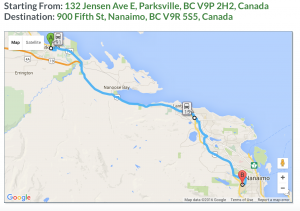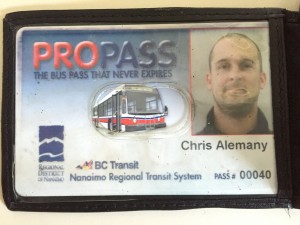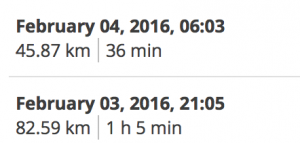Update: I’ve added the savings if someone was driving a car/truck that got more average mileage. (9L/100km or 26 USÂ mpg)
As many of you likely already know, I commute to work at VIU five days a week. Yup, this means driving back and forth everyday in some fashion.

Since about 2008 (I can’t even remember anymore haha) I have been taking advantage of the Regional District of Nanaimo BC Transit bus from Qualicum or Parksville to Woodgrove and then on to VIU. It adds between 30 and 60 minutes to the trip a day. On a ‘normal’ day I leave Port Alberni around 6AM, drive to Parksville Civic Centre, hop on the bus at 6:45, transfer at Woodgrove and end up at VIU around 7:30AM. On the way back it is a longer journey because of a long layover at Woodgrove and a ‘milk run’ to Parksville so I generally leave VIU at 3:35PM and arrive home at 5:30PM.  If you’re wondering if I’m the only person on the bus, nope not at all.  There are other VIU commuters (employees and students), High School students going to Nanaimo, other workers, many seniors going for day trips either to Nanaimo or often to Vancouver and beyond and other regular bus users, like kids going to the Mall or people who likely don’t have a lot of money, especially First Nations.  The use of the commuter bus between Parksville and Woodgrove has grown noticeably, especially as gas prices have risen.
 The cost of an RDN bus pass is $700 a year through the VIU “Pro Pass” program, which is pretty cool.  My pass is #0040.  I’m an early adopter… and as you can see from how grungy it is I use it a lot. The previous Federal Government also instituted a Tax Credit for all bus passes.  So I get 15% of that cost back ($105) so I am currently paying about $590 for the bus pass.
The cost of an RDN bus pass is $700 a year through the VIU “Pro Pass” program, which is pretty cool.  My pass is #0040.  I’m an early adopter… and as you can see from how grungy it is I use it a lot. The previous Federal Government also instituted a Tax Credit for all bus passes.  So I get 15% of that cost back ($105) so I am currently paying about $590 for the bus pass.
So why take the bus?

I get this question all the time.  The answer is simple.  Money, and stress. As you can see on the side, the full trip from home to VIU is about 82km.  The drive to Parksville is 45km. I used to drive to Qualicum which is shorter but they changed the bus routes two years ago and made the trip much longer.  So I save about 35km of driving.  That doesn’t seem like much, but in terms of stress on both myself and my car, I find the drive along Highway 19 to be far more stressful, and potentially dangerous, than the extremely familiar Highway 4.

Even in a fuel efficient car like my previous 2004 Toyota Echo Hatchback and my even more efficient 2012 Toyota Prius C, this year I saved myself about 9730km of driving by taking the bus. Â Not only does that mean 442L of fuel not burned and $505 saved on average, it also means 1.02 tonnes of CO2 not put into the atmosphere. (The buses would run anyway if I am on them or not of course). Â Compared to buying a parking pass for either $400 or $600 at VIU and add in the wear and tear on the vehicle and the economic argument is easy as is the safety. Â The time argument is the hard one but so far it works.
So now that you have two jobs….
As you might know, I decided to take on a new set of responsibilities (and have been honoured to be allowed to do so!). Â So my burning question over the past 12 months in the back of my geeky and miserly brain has been… with the additional driving that I have had to do to attend to City Council business, does it still make sense to take the bus whenever I can?
Well here are the numbers for the past 12 months.
I parked at VIU 41 times = $175 daily parking fees
I drove to VIU and parked for free elsewhere 30 times
(this is my late classes on Wednesdays when I can’t take the bus…)
The only thing I don’t have exact numbers for is days I took the bus, but working backwards I figure I had about 139 “bus days”.  At $700 that works out to around $5 a day.  Which is exactly the same as the cash fare ($2.50 each way).
Average mileage of my Toyota Prius over 2015: 4.548L/100km = 0.04548 L/km (51.7 U.S. mpg).
Home to VIU distance: 82km
Home to Parksville distance: 47km
Difference: 35km
So this year the money I spent on driving all the way to VIU was:
35km * 71 days * 2 = 4970km extra driving past Parksville = 226L fuel *1.144$/L = $258. Â Add $175 in parking fees and that’s $433. Â CO2 emitted: 0.52 tonnes CO2.
For the bus trips the money I saved was: 35km*139 bus days*2 = 9730km avoided on bus = 442L fuel *1.144$/L = $505 saved = 1.02 tonnes CO2 not emitted.
So taking all of it together and comparing the two:
VIU Bus Pro Pass = $695.24 – $105 tax credit = $590 (15% tax credit)
Extra Driving = $258
Parking tickets = $175
Total with Bus = $1003
CO2 from Driving Parskville to VIU when needed = 0.52 tonnes
If I did not take the bus:
VIU “Econo” limited Parking pass = $400
Driving = $258+$505 = $763
Total without bus = $1163
If I get a VIU “Employee” pass, the cost rises to $600 and total is $1363.
CO2 from Driving from Parksville to VIU full time. = 1.52 tonnes
So I save $160 and 1 tonnes of CO2 not including wear and tear on the vehicle.
Update: You might be wondering how much of a difference the type of car makes. Â The answer is a lot. Â My Prius C gets 4.5L/100km or 51 US mpg. Â If I instead took our 2007 Toyota Matrix which gets around 9L/100km or 26 US mpg the totals would be:
For the Bus: Fuel: 447L/$511 Total: $1386 and 1.03T of CO2
Without the Bus: 875L/$1001 (plus above) Total: $1912 and 2.02T of CO2.
So in an “average” mileage car I would save $526 and 2T of CO2.
Now these numbers are not going to be perfect but they should be pretty darn close to accurate. So even with the additional driving that I have had to do with the new City Council duties, it still makes sense for me to take the bus as much as possible both from a cost perspective and an environmental perspective.  And that does not include additional maintenance costs or consideration on safety.
Public Transit saves everyone money

Commuting isn’t going anywhere anytime soon.  Especially with home price differences so great between Port Alberni and other mid-island communities I believe we will see more commuters, not less.  This is why I continue to advocate for transit options to open up between Parksville and Port Alberni either with a bus like the one between Parskville and Woodgrove or using the Railway (see the link).  The cost savings are substantial both to people and to the taxpayer in terms of maintenance on roadways and safety, which means more money in everyones pocket to spend on other things. The benefit to the environment and overall safety is obvious.

